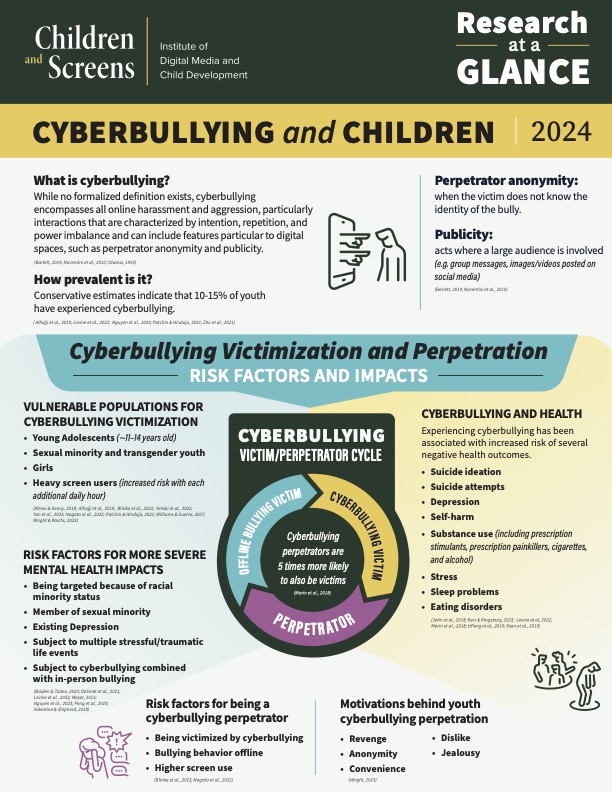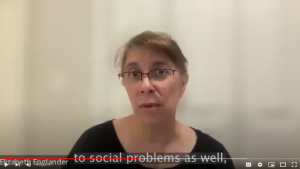Cyberbullying and youth –  what does the research say? How prevalent is it? Who is vulnerable? How does it impact child health? Is there a relationship between being a cyberbullying victim and a perpetrator? What are the most effective strategies to prevent and cope with cyberbullying?
what does the research say? How prevalent is it? Who is vulnerable? How does it impact child health? Is there a relationship between being a cyberbullying victim and a perpetrator? What are the most effective strategies to prevent and cope with cyberbullying?
Children and Screens’ Research-at-a-Glance on “Cyberbullying and Children” provides a quick, printable, and accessible resource with current and quality research on cyberbullying and children.
Abreu, R. L., & Kenny, M. C. (2018). Cyberbullying and LGBTQ youth: A systematic literature review and recommendations for prevention and intervention. Journal of Child & Adolescent Trauma, 11, 81–97. https://doi.org/10.1007/s40653-017-0175-7
Alhajji, M., Bass, S., & Dai, T. (2019). Cyberbullying, mental health, and violence in adolescents and associations with sex and race: Data from the 2015 youth risk behavior survey. Global Pediatric Health, 6. https://doi.org/10.1177/2333794×19868887
Baiden, P., & Tadeo, S. K. (2020). Investigating the association between bullying victimization and suicidal ideation among adolescents: Evidence from the 2017 youth risk behavior survey. Child Abuse & Neglect, 102, 104417. https://doi.org/10.1016/j.chiabu.2020.104417
Barlett, C. P. (2019). Predicting cyberbullying: Research, theory, and intervention. Academic Press.
Bezerra, L. L., Alves, D. L., Nunes, B. R., Stelko‐Pereira, A. C., Florêncio, R. S., & Gomes, I. L. (2023). Anti‐bullying interventions with an emphasis on bystanders: A scoping review. Journal of School Health 93(11), 1036-1044. https://doi.org/10.1111/josh.13349
Blinka, L., Stašek, A., Šablatúrová, N., Ševčíková, A., & Husarova, D. (2023). Adolescents’ problematic internet and smartphone use in (cyber)bullying experiences: A network analysis. Child and Adolescent Mental Health, 28(1), 60–66. https://doi.org/10.1111/camh.12628
Chen, L., Liu, X., & Tang, H. (2023). The interactive effects of parental mediation strategies in preventing cyberbullying on social media. Psychology Research and Behavior Management, 16, 1009–1022. https://doi.org/10.2147/prbm.s386968
DeSmet, A., Rodelli, M., Walrave, M., Portzky, G., Dumon, E., & Soenens, B. (2021). The moderating role of parenting dimensions in the association between traditional or cyberbullying victimization and mental health among adolescents of different sexual orientation. International Journal of Environmental Research and Public Health, 18(6), 2867. https://doi.org/10.3390/ijerph18062867
Eroglu, Y., Peker, A., & Cengiz, S. (2022). Cyber victimization and well-being in adolescents: The sequential mediation role of forgiveness and coping with cyberbullying. Frontiers in Psychology, 13. https://doi.org/10.3389/fpsyg.2022.819049
John, A., Glendenning, A. C., Marchant, A., Montgomery, P., Stewart, A., Wood, S., Lloyd, K., & Hawton, K. (2018). Self-harm, suicidal behaviours, and cyberbullying in children and Young People: Systematic Review. Journal of Medical Internet Research, 20(4), e129. https://doi.org/10.2196/jmir.9044
Kerr, S., & Kingsbury, M. (2023). Online digital media use and adolescent mental health. Health Reports, 34(2), 17–28. https://doi.org/10.25318/82-003-x202300200002-eng
Kreski, N. T., Chen, Q., Olfson, M., Cerdá, M., Martins, S. S., Mauro, P. M., Branas, C. C., Rajan, S., & Keyes, K. M. (2022). Experiences of online bullying and offline violence‐related behaviors among a nationally representative sample of adolescents, 2011 to 2019. Journal of School Health, 92(4), 376–386. https://doi.org/10.1111/josh.13144
Lee, A. Y., & Hancock, J. T. (2023). Developing digital resilience: An educational intervention improves elementary students’ response to digital challenges. Computers and Education Open, 5, 100144. https://doi.org/10.1016/j.caeo.2023.100144
Levine, R. S., Bintliff, A. V., & Raj, A. (2022). Gendered analysis of cyberbullying victimization and its associations with suicidality: Findings from the 2019 Youth Risk Behavior Survey. Adolescents, 2(2), 235–251. https://doi.org/10.3390/adolescents2020019
Meyer, I. H. (2013). Prejudice, social stress, and Mental Health in lesbian, gay, and bisexual populations: Conceptual issues and research evidence. Psychology of Sexual Orientation and Gender Diversity, 1(S), 3–26. https://doi.org/10.1037/2329-0382.1.s.3
Morin, H. K., Bradshaw, C. P., & Kush, J. M. (2018). Adjustment outcomes of victims of cyberbullying: The role of personal and contextual factors. Journal of School Psychology, 70, 74–88. https://doi.org/10.1016/j.jsp.2018.07.002
Nagata, J. M., Trompeter, N., Singh, G., Ganson, K. T., Testa, A., Jackson, D. B., Assari, S., Murray, S. B., Bibbins-Domingo, K., & Baker, F. C. (2022). Social Epidemiology of early adolescent cyberbullying in the United States. Academic Pediatrics, 22(8), 1287–1293. https://doi.org/10.1016/j.acap.2022.07.003
Nguyen, T. H., Shah, G., Muzamil, M., Ikhile, O., Ayangunna, E., & Kaur, R. (2023). Association of in-school and electronic bullying with suicidality and feelings of hopelessness among adolescents in the United States. Children, 10(4), 755. https://doi.org/10.3390/children10040755
Nocentini, A., Calmaestra, J., Schultze-Krumbholz, A., Scheithauer, H., Ortega, R., & Menesini, E. (2010). Cyberbullying: Labels, behaviours and definition in three European countries. Australian Journal of Guidance and Counselling, 20(2), 129–142. https://doi.org/10.1375/ajgc.20.2.129
Olweus, D. (1993). Bullying at school: What we know and what we can do. Blackwell Publishing.
Patchin, J. W., & Hinduja, S. (2021). Cyberbullying among tweens in the United States: Prevalence, impact, and helping behaviors. The Journal of Early Adolescence, 42(3), 414–430. https://doi.org/10.1177/02724316211036740
Peng, Z., Klomek, A. B., Li, L., Su, X., Sillanmäki, L., Chudal, R., & Sourander, A. (2019). Associations between Chinese adolescents subjected to traditional and cyber bullying and suicidal ideation, self-harm and suicide attempts. BMC Psychiatry, 19. https://doi.org/10.1186/s12888-019-2319-9
Valentine, S. E., & Shipherd, J. C. (2018). A systematic review of social stress and mental health among transgender and gender non-conforming people in the United States. Clinical Psychology Review, 66, 24–38. https://doi.org/10.1016/j.cpr.2018.03.003
Williams, K. R., & Guerra, N. G. (2007). Prevalence and predictors of internet bullying. Journal of Adolescent Health, 41(6), S14-S21. https://doi.org/10.1016/j.jadohealth.2007.08.018
Wright, M. F. (2023). Adolescent cyberbullies’ attributions: Longitudinal Linkages to cyberbullying perpetration. International Journal of Environmental Research and Public Health, 20(12), 6083. https://doi.org/10.3390/ijerph20126083
Wright, M. F., & Wachs, S. (2023). Cyberbullying involvement and depression among elementary school, Middle School, high school, and university students: The role of Social Support and Gender. International Journal of Environmental Research and Public Health, 20(4), 2835. https://doi.org/10.3390/ijerph20042835
Wright, M.F., & Wachs, S. (2018). Does parental mediation moderate the longitudinal association among bystanders and perpetrators and victims of cyberbullying? Social Sciences, 7(11), 231. https://doi.org/10.3390/socsci7110231
Wu, W., Guo, Z., Li, S., Tu, F., Wu, X., Ma, X., Teng, Z., Chen, Y., & Zeng, Y. (2022). The influence of parental autonomy support on cyberbullying victimization of high school students: A latent moderation analysis. Acta Psychologica, 230, 103739. https://doi.org/10.1016/j.actpsy.2022.103739
Yan, W., Yuan, Y., Yang, M., Zhang, P., & Peng, K. (2023). Detecting the risk of bullying victimization among adolescents: A large-scale machine learning approach. Computers in Human Behavior, 147, 107817. https://doi.org/10.1016/j.chb.2023.107817
Yoon, Y., Lee, J. O., Cho, J., Bello, M. S., Khoddam, R., Riggs, N. R., & Leventhal, A. M. (2019). Association of cyberbullying involvement with subsequent substance use among adolescents. Journal of Adolescent Health, 65(5), 613–620. https://doi.org/10.1016/j.jadohealth.2019.05.006
Zhu, C., Huang, S., Evans, R., & Zhang, W. (2021). Cyberbullying among adolescents and children: A comprehensive review of the global situation, risk factors, and preventive measures. Frontiers in Public Health, 9. https://doi.org/10.3389/fpubh.2021.634909



